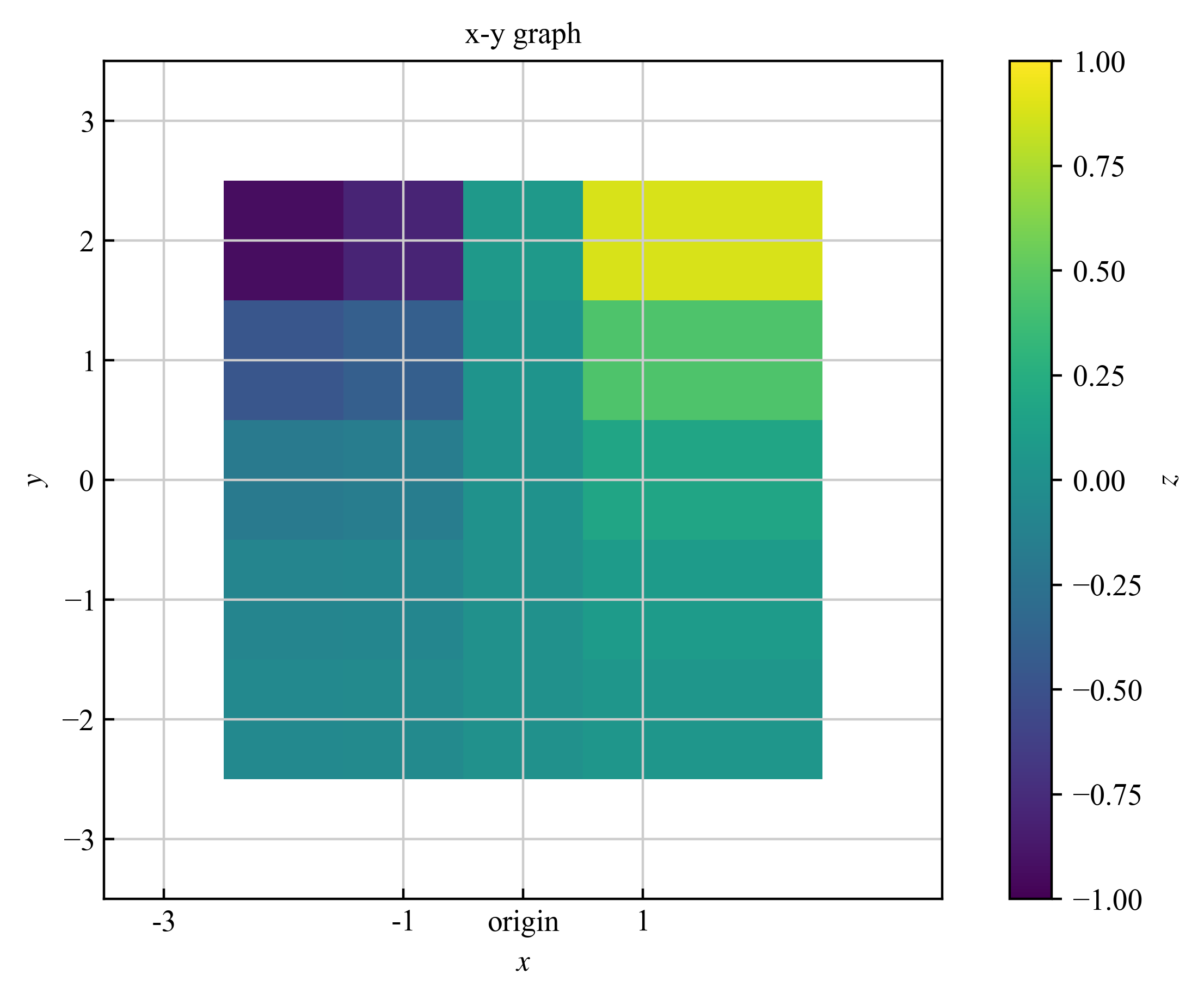グラフ作成用の関数 #
1. x-y グラフを画像として保存する関数 plot_xy #
def plot_xy
import numpy as np
import matplotlib.pyplot as plt
import matplotlib.ticker as tck
# plt.rcParams["axes.prop_cycle"] = plt.cycler(
# color=["#000000", "#ff0000", "#0000ff", "#228b22", "#ff00ff", "#ffd900", "#00ffff", "#7f00ff", "#ff7f00", "#00ff7f", "#bebebe", "#666666"]
# )
def plot_xy(
x_dict: dict[str, np.ndarray],
y_dict: dict[str, np.ndarray],
y_dict_error: dict[str, np.ndarray] = {},
output_image_name: str | None = None, # "out.png"
show_gui: bool = True,
data_optional: dict[str, dict] | None = None,
title_name: str = "x-y graph",
title_font_size: int | str = "default",
title_v_offset: float | int | str = "default",
figure_size: tuple[int, int] = (7, 5),
aspect_ratio: str | float = "auto",
legend_loc: tuple[float, float] | str | None = None, # ,"upper left",
legend_transparent: float = 0.5,
legend_bg_color: str = "default",
legend_edge_color: str = "default",
x_scale: str = "linear",
x_base: float | int | str = "auto",
x_start_tick: float = None,
x_end_tick: float = None,
x_range: tuple[float, float] | str = "auto",
x_major_ticks_manual: tuple | None = None,
x_label: str = "$x$",
x_grid: str = "major",
x_ticks_direction: str = "in",
is_x_minor_ticks: bool = False,
x_minor_ticks_manual: tuple | None = None,
x_minor_division: int = 1,
x_invert: bool = False,
y_scale: str = "linear",
y_base: float | int | str = "auto",
y_range: tuple[float, float] | str = "auto",
y_start_tick: float = None,
y_end_tick: float = None,
y_major_ticks_manual: tuple | None = None,
y_label: str = "$y$",
y_grid: str = "major",
y_ticks_direction: str = "in",
is_y_minor_ticks: bool = False,
y_minor_ticks_manual: tuple | None = None,
y_minor_division: int = 1,
y_invert: bool = False,
default_font_family: str = "Times New Roman",
default_font_size: int = 10,
default_font_set: str = "stix",
) -> None:
plt.rcdefaults()
plt.rcParams["font.family"] = default_font_family # font
plt.rcParams["font.size"] = default_font_size # character size
plt.rcParams["mathtext.fontset"] = default_font_set # font Math
# ===================
# 1. Global settings
# ===================
# - Make figure and subplots
fig, axs = plt.subplots(1, 1, figsize=figure_size)
# - Aspect ratio
axs.set_aspect(aspect_ratio, adjustable="box")
# - Plot data and it's label in legend
# print(data_optional, show_error_bar)
if data_optional is None:
for k in y_dict.keys():
# if show_error_bar:
if y_dict_error.get(k) is not None:
axs.errorbar(x_dict[k], y_dict[k], yerr=y_dict_error[k], elinewidth=1, fmt=".-", ms=3, label=k, capsize=2, capthick=1)
else:
axs.plot(x_dict[k], y_dict[k], ".-", ms=3, label=k)
else:
for k in y_dict.keys():
p = data_optional.get(k)
if p is not None:
fmt = p.get("fmt") if p.get("fmt") is not None else ".-"
data_label = p.get("ti") if p.get("ti") is not None else k
line_width = p.get("lw") if p.get("lw") is not None else 1
line_color = p.get("lc") if p.get("lc") is not None else "C0"
marker_size = p.get("ms") if p.get("ms") is not None else 3
e_line_width = p.get("ew") if p.get("ew") is not None else line_width / 2
cap_size = p.get("cs") if p.get("cs") is not None else 2
cap_thick = p.get("ct") if p.get("ct") is not None else 1
if y_dict_error.get(k) is not None:
axs.errorbar(
x_dict[k],
y_dict[k],
yerr=y_dict_error[k],
fmt=fmt,
lw=line_width,
ms=marker_size,
label=data_label,
color=line_color,
elinewidth=e_line_width,
capsize=cap_size,
capthick=cap_thick,
)
else:
axs.plot(x_dict[k], y_dict[k], fmt, lw=line_width, ms=marker_size, label=data_label, color=line_color)
else:
if y_dict_error.get(k) is not None:
axs.errorbar(
x_dict[k],
y_dict[k],
yerr=y_dict_error[k],
label=k,
elinewidth=1,
capsize=2,
capthick=1,
)
else:
axs.plot(
x_dict[k],
y_dict[k],
label=k,
)
# - Legend
legend_location = legend_loc if isinstance(legend_loc, (tuple, str)) else plt.rcParams["legend.loc"]
framealpha = legend_transparent if isinstance(legend_transparent, float) else plt.rcParams["legend.framealpha"]
legend_facecolor = legend_bg_color if legend_bg_color != "default" else None
legend_edgecolor = legend_edge_color if legend_edge_color != "default" else None
axs.legend(
loc=legend_location,
framealpha=framealpha,
fancybox=True,
facecolor=legend_facecolor,
edgecolor=legend_edgecolor,
)
# - Title
i0 = title_font_size if isinstance(title_font_size, int) else plt.rcParams["font.size"]
f0 = title_v_offset if isinstance(title_v_offset, (int, float)) else plt.rcParams["axes.titlepad"]
axs.set_title(title_name, pad=f0, fontsize=i0)
# ========
# 2. Axis
# ========
axs.grid(False)
axs.minorticks_off()
# -----------
# 2.1 x-axis
# -----------
# - x Label
axs.set_xlabel(x_label)
# - x Grid
if x_grid in ["major", "both"]:
axs.grid(axis="x", which="major", color="#cccccc", linestyle="-") # show x-axis grid
if x_grid in ["minor", "both"]:
axs.grid(axis="x", which="minor", color="#e7e7e7", linestyle="--") # show x-axis sub-grid
# - x Ticks
axs.tick_params(axis="x", which="both", direction=x_ticks_direction)
if x_scale == "linear":
axs.set_xscale(x_scale)
# -- Major ticks location
if x_major_ticks_manual is None:
if x_start_tick is None and x_end_tick is None:
if isinstance(x_base, (float, int)):
axs.xaxis.set_major_locator(tck.MultipleLocator(base=float(x_base)))
else:
axs.xaxis.set_major_locator(tck.MaxNLocator(nbins="auto"))
else:
if isinstance(x_base, (float, int)):
xstart, xend = axs.get_xlim()
if x_start_tick is not None:
xstart = x_start_tick if x_range != "auto" else x_range[0]
if x_end_tick is not None:
xend = x_end_tick if x_range != "auto" else x_range[1]
ticks = np.arange(xstart, xend, x_base)
axs.set_xticks(ticks)
else:
axs.xaxis.set_major_locator(tck.MaxNLocator(nbins="auto"))
# -- Major ticks label format
mj_formatter = tck.ScalarFormatter()
mj_formatter.set_scientific(True) # Enable Scientific notation
mj_formatter.set_powerlimits(plt.rcParams["axes.formatter.limits"])
mj_formatter.set_useMathText(True) # (False)1e8, (True)10^8
axs.xaxis.set_major_formatter(mj_formatter)
else:
axs.set_xticks(x_major_ticks_manual[0])
axs.xaxis.set_major_formatter(tck.FixedFormatter(x_major_ticks_manual[1]))
# -- Minor ticks location
if is_x_minor_ticks:
axs.xaxis.set_minor_formatter(tck.NullFormatter())
if x_minor_ticks_manual is None:
axs.xaxis.set_minor_locator(tck.AutoMinorLocator(n=x_minor_division))
else:
axs.xaxis.set_minor_locator(tck.FixedLocator(x_minor_ticks_manual))
elif x_scale == "log":
axs.set_xscale(x_scale)
x_log_base = x_base if isinstance(x_base, (float, int)) else 10.0
if x_major_ticks_manual is None:
# -- Major ticks location
# Calc the position at integer power
a_min_list = []
a_max_list = []
for k in x_dict.keys():
a_min_list.append(np.amin(x_dict[k]))
a_max_list.append(np.amax(x_dict[k]))
a_min = np.amin(a_min_list)
a_max = np.amin(a_max_list)
n_power_min = np.floor(np.log(a_min) / np.log(x_log_base)).astype(int)
n_power_max = np.ceil(np.log(a_max) / np.log(x_log_base)).astype(int)
ticks = [x_log_base**i for i in range(n_power_min - 1, n_power_max + 2)]
# Set the ticks location clearly
axs.xaxis.set_major_locator(tck.FixedLocator(ticks))
# -- Major ticks label format
mj_formatter = tck.LogFormatterMathtext(base=x_log_base, labelOnlyBase=True)
axs.xaxis.set_major_formatter(mj_formatter)
else:
axs.xaxis.set_major_locator(tck.FixedLocator(x_major_ticks_manual[0]))
axs.xaxis.set_major_formatter(tck.FixedFormatter(x_major_ticks_manual[1]))
# -- Minor ticks location
if is_x_minor_ticks:
axs.xaxis.set_minor_formatter(tck.NullFormatter())
if x_minor_division is None:
axs.xaxis.set_minor_locator(tck.LogLocator(base=x_log_base, subs=None))
else:
axs.xaxis.set_minor_locator(tck.LogLocator(base=x_log_base, subs=np.arange(1.0, x_minor_division, 1) * (1.0 / x_minor_division)))
else:
raise ValueError(f'x_scale must be "linear" or "log", your x_scale={x_scale}')
# - x Range
if isinstance(x_range, tuple):
axs.set_xlim(x_range[0], x_range[1])
else:
axs.set_xlim(auto=True)
if x_invert:
axs.invert_xaxis()
# -----------
# 2.2 y-axis
# -----------
# - y Label
axs.set_ylabel(y_label)
# - y Grid
if y_grid in ["major", "both"]:
axs.grid(axis="y", which="major", color="#cccccc", linestyle="-") # show y-axis grid
if y_grid in ["minor", "both"]:
axs.grid(axis="y", which="minor", color="#e7e7e7", linestyle="--") # show y-axis sub-grid
# - y Ticks
axs.tick_params(axis="y", which="both", direction=y_ticks_direction)
if y_scale == "linear":
axs.set_yscale(y_scale)
if y_major_ticks_manual is None:
if y_start_tick is None and y_end_tick is None:
if isinstance(y_base, (float, int)):
axs.yaxis.set_major_locator(tck.MultipleLocator(base=float(y_base)))
else:
axs.yaxis.set_major_locator(tck.MaxNLocator(nbins="auto"))
else:
if isinstance(y_base, (float, int)):
# define ticks by start and interval
ystart, yend = axs.get_ylim()
if y_start_tick is not None:
ystart = y_start_tick if y_range != "auto" else y_range[0]
if y_end_tick is not None:
yend = y_end_tick if y_range != "auto" else y_range[1]
ticks = np.arange(ystart, yend, y_base)
axs.set_yticks(ticks)
else:
axs.yaxis.set_major_locator(tck.MaxNLocator(nbins="auto"))
# -- Major ticks label format
mj_formatter = tck.ScalarFormatter()
mj_formatter.set_scientific(True) # Enable Scientific notation
mj_formatter.set_powerlimits(plt.rcParams["axes.formatter.limits"])
# (set_powerlimits: Normal notation range, otherwise Scientific notation.)
mj_formatter.set_useMathText(True) # (False)1e8, (True)10^8
axs.yaxis.set_major_formatter(mj_formatter)
else:
# axs.set_yticks(y_major_ticks_manual[0])
axs.yaxis.set_major_locator(tck.FixedLocator(y_major_ticks_manual[0]))
axs.yaxis.set_major_formatter(tck.FixedFormatter(y_major_ticks_manual[1]))
# -- Minor ticks location
if is_y_minor_ticks:
axs.yaxis.set_minor_formatter(tck.NullFormatter())
if y_minor_ticks_manual is None:
axs.yaxis.set_minor_locator(tck.AutoMinorLocator(n=y_minor_division))
else:
axs.yaxis.set_minor_locator(tck.FixedLocator(y_minor_ticks_manual))
elif y_scale == "log":
axs.set_yscale(y_scale)
y_log_base = y_base if isinstance(y_base, (float, int)) else 10.0
if y_major_ticks_manual is None:
# -- Major ticks location
# Calc the position at integer power
a_min_list = []
a_max_list = []
for k in y_dict.keys():
a_min_list.append(np.amin(y_dict[k]))
a_max_list.append(np.amax(y_dict[k]))
a_min = np.amin(a_min_list)
a_max = np.amin(a_max_list)
n_power_min = np.floor(np.log(a_min) / np.log(y_log_base)).astype(int)
n_power_max = np.ceil(np.log(a_max) / np.log(y_log_base)).astype(int)
ticks = [y_log_base**i for i in range(n_power_min - 1, n_power_max + 2)]
# Set the ticks location clearly
axs.yaxis.set_major_locator(tck.FixedLocator(ticks))
# -- Major ticks label format
mj_formatter = tck.LogFormatterMathtext(base=y_log_base, labelOnlyBase=True)
axs.yaxis.set_major_formatter(mj_formatter)
else:
axs.set_yticks(y_major_ticks_manual[0])
axs.yaxis.set_major_formatter(tck.FixedFormatter(y_major_ticks_manual[1]))
# -- Minor ticks location
if is_y_minor_ticks:
axs.yaxis.set_minor_formatter(tck.NullFormatter())
if y_minor_division is None:
axs.yaxis.set_minor_locator(tck.LogLocator(base=y_log_base, subs=None))
else:
axs.yaxis.set_minor_locator(tck.LogLocator(base=y_log_base, subs=np.arange(1.0, y_minor_division, 1) * (1.0 / y_minor_division)))
else:
raise ValueError(f'y_scale must be "linear" or "log", your y_scale={y_scale}')
# - y Range
if isinstance(y_range, tuple):
axs.set_ylim(y_range[0], y_range[1])
else:
axs.set_ylim(auto=True)
if y_invert:
axs.invert_yaxis()
# ==========
# 3. Output
# ==========
# - Pop up GUI
if show_gui:
plt.show()
# - output image
if output_image_name is not None:
if output_image_name.endswith(".eps"):
# Don't plot the left-bottom region because the Bounding Box has negative value
fig.subplots_adjust(left=0.3, right=0.9, bottom=0.3, top=0.9)
# Save figure
fig.savefig(output_image_name, dpi=400, bbox_inches="tight")
plt.close()
1.1. シンプルなプロットの場合 #
import numpy as np
from plot_xy import plot_xy
if __name__ == "__main__":
x_arr = np.linspace(0.0, 10.0, 101)
y_arr = np.cos(x_arr)
x = {"plot1": x_arr}
y = {"plot1": y_arr}
output_name = "out1.png"
plot_xy(x, y, output_image_name=output_name)
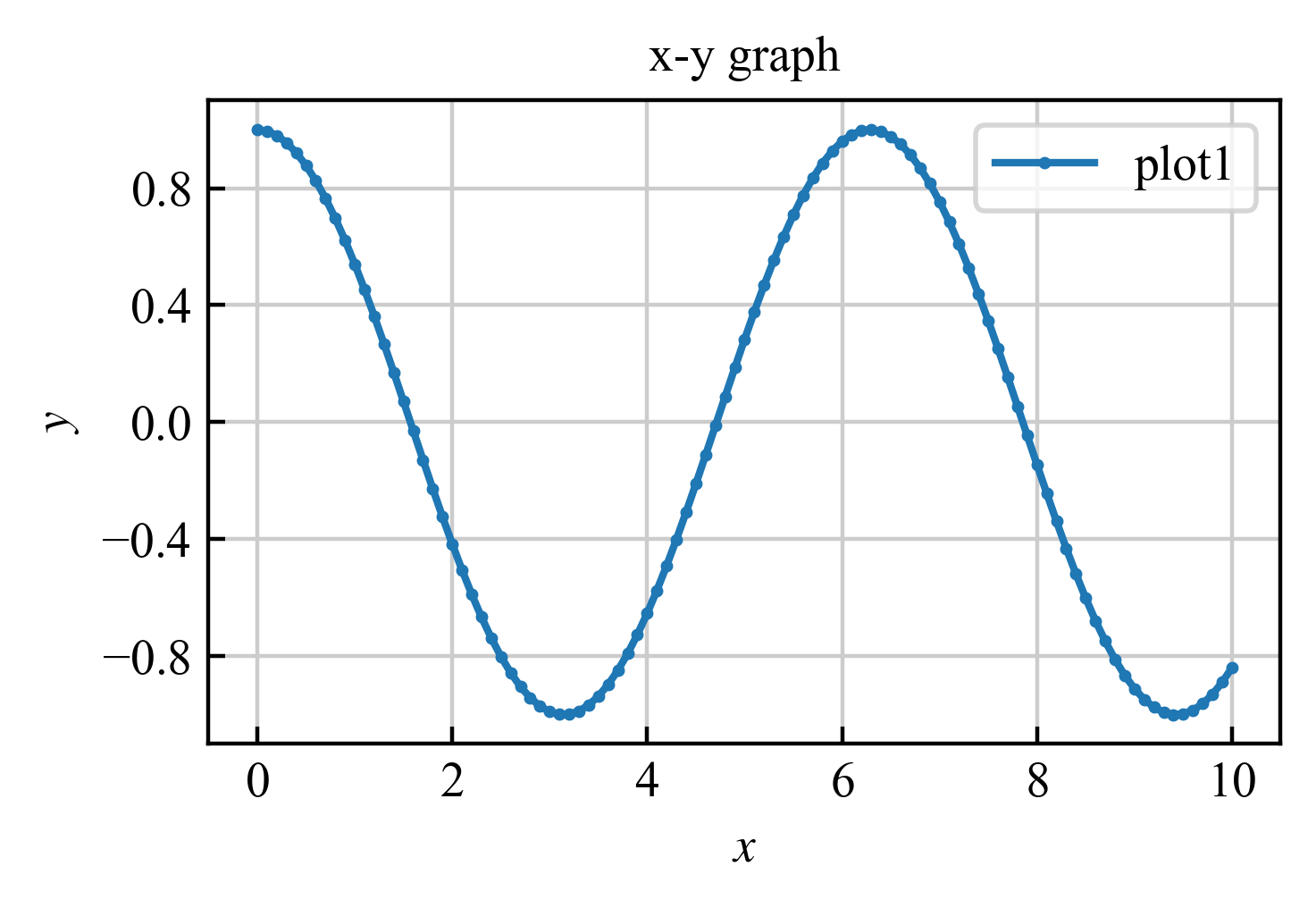
1.2. 複数のプロットを表示 #
import numpy as np
from plot_xy import plot_xy
if __name__ == "__main__":
x1_arr = np.linspace(0.0, 10.0, 101)
x2_arr = np.linspace(0.0, 20.0, 41)
y1_arr = np.cos(x1_arr)
y2_arr = np.sin(x2_arr)
x = {"plot1": x1_arr, "plot2": x2_arr}
y = {"plot1": y1_arr, "plot2": y2_arr}
output_name = "out2.png"
plot_xy(x, y, output_image_name=output_name)
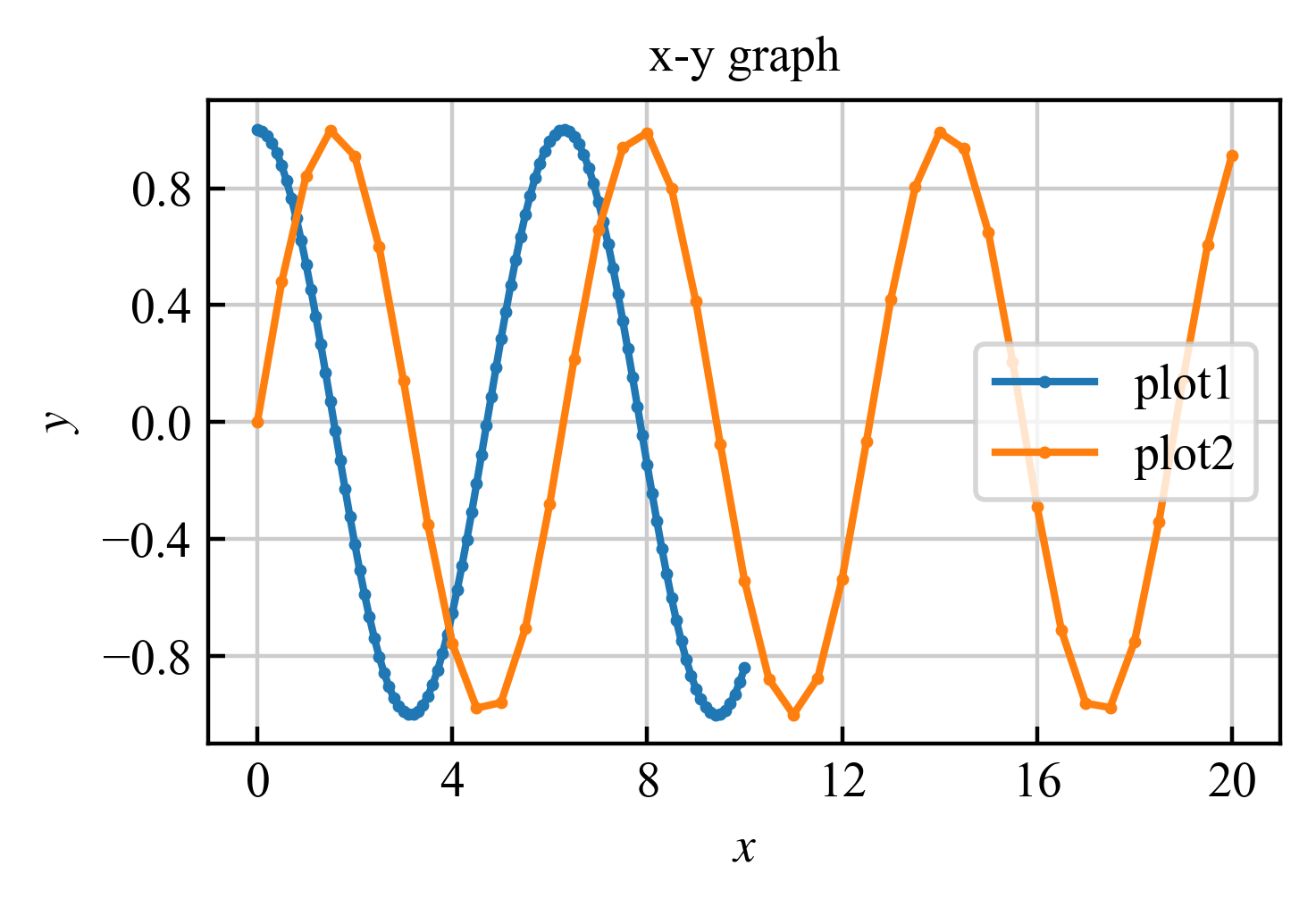
1.3. 線の色などを変更する #
import numpy as np
from plot_xy import plot_xy
if __name__ == "__main__":
x1_arr = np.linspace(0.0, 10.0, 101)
x2_arr = np.linspace(0.0, 20.0, 41)
y1_arr = np.cos(x1_arr)
y2_arr = np.sin(x2_arr)
x = {"plot1": x1_arr, "plot2": x2_arr}
y = {"plot1": y1_arr, "plot2": y2_arr}
output_name = "out3.png"
data_optional = {
"plot1": {"ti": "data $f(x)$", "fmt": "-", "lw": 3, "ms": 4},
"plot2": {"ti": "data $g(x)$", "fmt": ".-", "lw": 1, "ms": 2},
}
plot_xy(x, y, output_image_name=output_name, data_optional=data_optional)
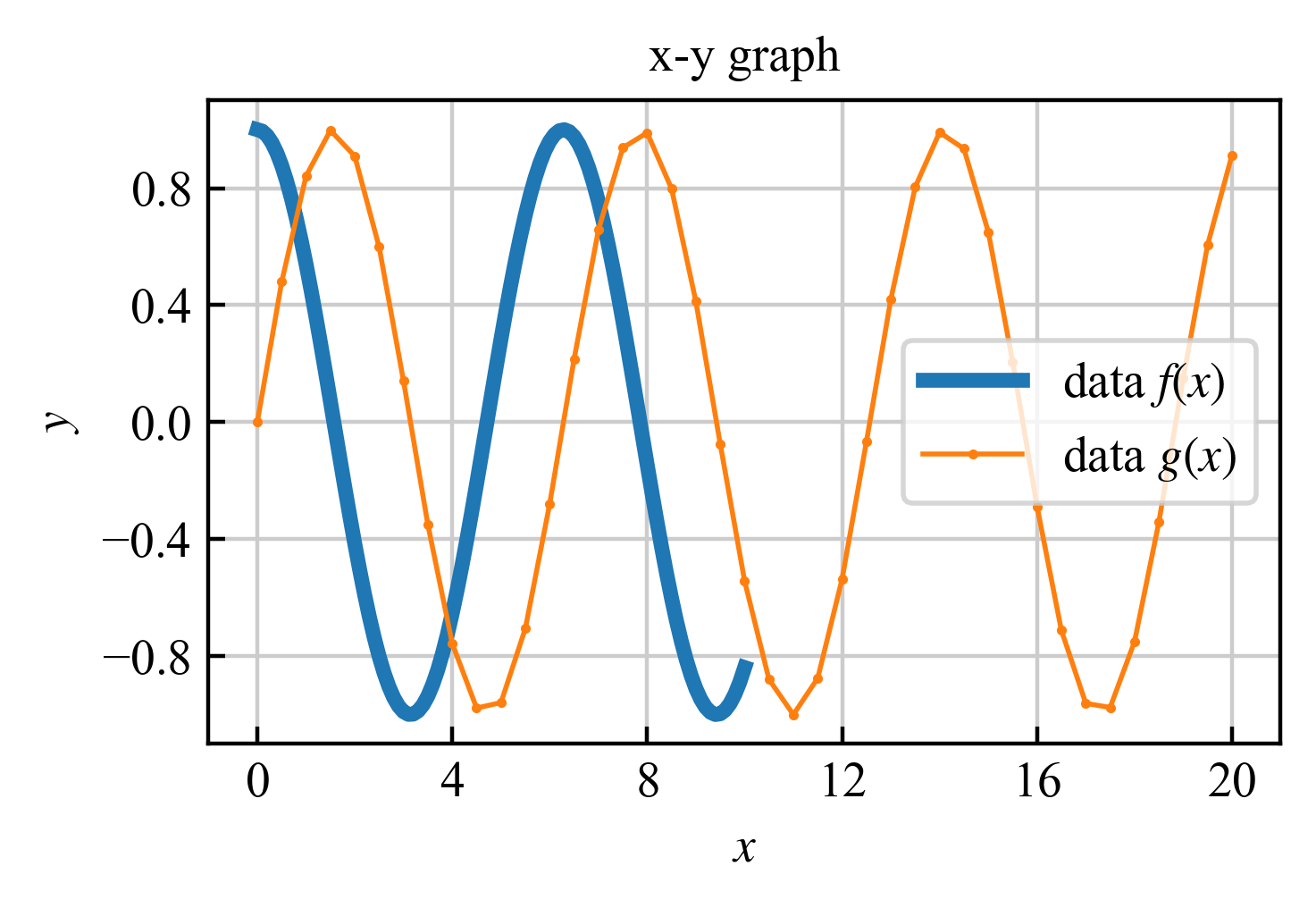
import numpy as np
from plot_xy import plot_xy
if __name__ == "__main__":
x_arr = np.linspace(0.0, 20.0, 101)
y_arr = 1 / (x_arr**2 + 1)
x = {"plot1": x_arr}
y = {"plot1": y_arr}
output_name = "out4.png"
data_optional = {"plot1": {"ti": "data $f(x)$", "fmt": ".-", "lw": 2, "ms": 4}}
plot_xy(
x,
y,
output_image_name=output_name,
data_optional=data_optional,
title_name="Graph using all settings",
show_gui=True, # True*, False
title_font_size=12, # (integer), "default"*
title_v_offset="default", # (float), "default"*
figure_size=(5, 5), # ((int), (int))
x_scale="linear", # "linear"*, "log"
x_base=2, # x_scale="linear": interval of major ticks, ="log": base of logarithrm
x_range=(0.0, 14.0), # ((range start),(range end)), "auto"*
x_ticks_manual=([0, 1, 2, 5, 6.5, 11], ["origin", "1", "x=2", "5", "6.5", "$x=11$"]), # , None*
x_label="x-axis label", # (string)
x_grid="both", # "minor", "major"*, "both"
x_ticks_direction="out", # "in"*, "out"
is_x_minor_ticks=True, # True, False*
x_minor_division=2, # Num. of divisions of x_base
y_scale="log",
y_base=10,
y_range="auto",
y_ticks_manual=None,
y_label="y-axis new label $\log_{10}f(x)$",
y_grid="both",
y_ticks_direction="in",
is_y_minor_ticks=True,
y_minor_division=10,
legend_loc=(0.2, 0.55), # ((0.0-1.0), (0.0-1.0)), "default"*
)
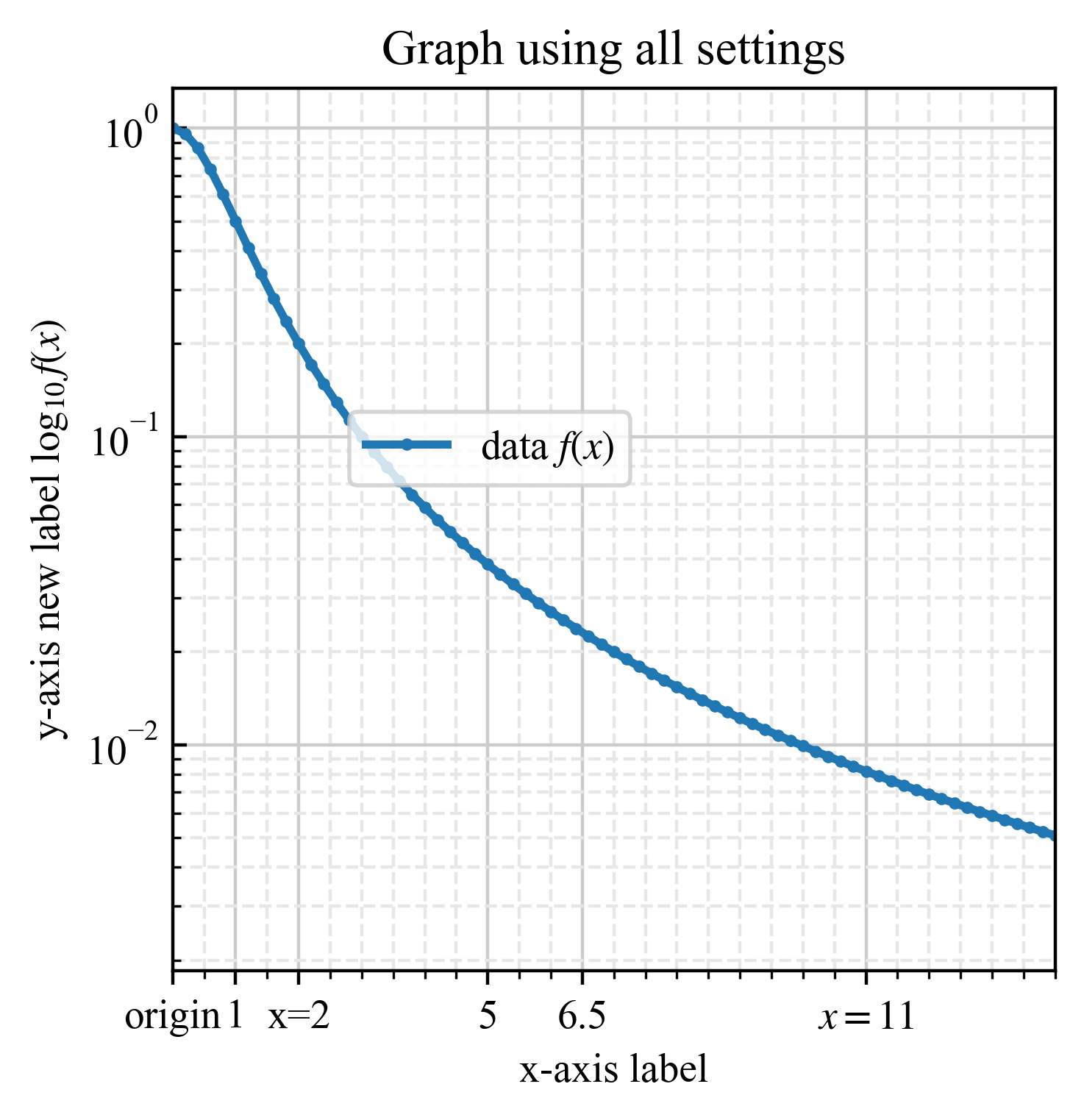
1.4. フォントの変更など #
import numpy as np
from plot_xy import plot_xy
if __name__ == "__main__":
x1 = np.linspace(-10, 5, 101)
x2 = np.linspace(-10, 5, 41)
x3 = np.linspace(-5, 8, 21)
y1 = 1.0 / (x1**2 + 1)
y2 = np.sin(x2)
y3 = np.cos(x3)
# ------
x = {"plot1": x1, "plot2": x2, "plot3": x3}
y = {"plot1": y1, "plot2": y2, "plot3": y3}
data_optional = {
"plot1": {"fmt": "--", "ti": "plot 1 title", "lw": 3, "lc": "red"},
"plot2": {"fmt": "x-", "ms": 4, "lc": "#471bb9"},
"plot3": {},
}
output_image = "out_linear.png"
x_major_ticks_manual = ([-10, -5, 0, 2, 3], ["$-10$", "$-5$", "origin", "$x=2$", "$3$"])
x_minor_ticks_manual = np.arange(-14, 8, 1).tolist()
plot_xy(
x,
y,
output_image_name=output_image,
show_gui=True,
data_optional=data_optional,
title_name=r"linear graph title, LaTeX notation $\frac{d^n}{dx^n}f_{\mathrm{in}}(x_k) \sum_{i=1}^N \int dx c_i(x)$",
title_font_size=12,
title_v_offset=20,
figure_size=(6, 4),
aspect_ratio=4,
legend_loc=(0.05, 0.7),
legend_transparent=0.2,
legend_bg_color="green",
legend_edge_color="red",
x_scale="linear",
# x_base=10,
x_range=(-12.0, 7.0),
# x_start_tick=5,
# x_end_tick=3,
x_major_ticks_manual=x_major_ticks_manual,
x_label="x-axis $x$ [arb. unit]",
x_grid="both",
x_ticks_direction="in",
is_x_minor_ticks=True,
# x_minor_division=2,
x_minor_ticks_manual=x_minor_ticks_manual,
y_scale="linear",
y_base=0.3,
y_range=(-1.3, 1.3),
y_start_tick=-1,
y_end_tick=0.3,
# y_major_ticks_manual=y_major_ticks_manual,
y_label="y-axis $y$ [arb. unit]",
y_grid="both",
y_ticks_direction="in",
is_y_minor_ticks=True,
y_minor_division=3,
# y_minor_ticks_manual=y_minor_ticks_manual,
)
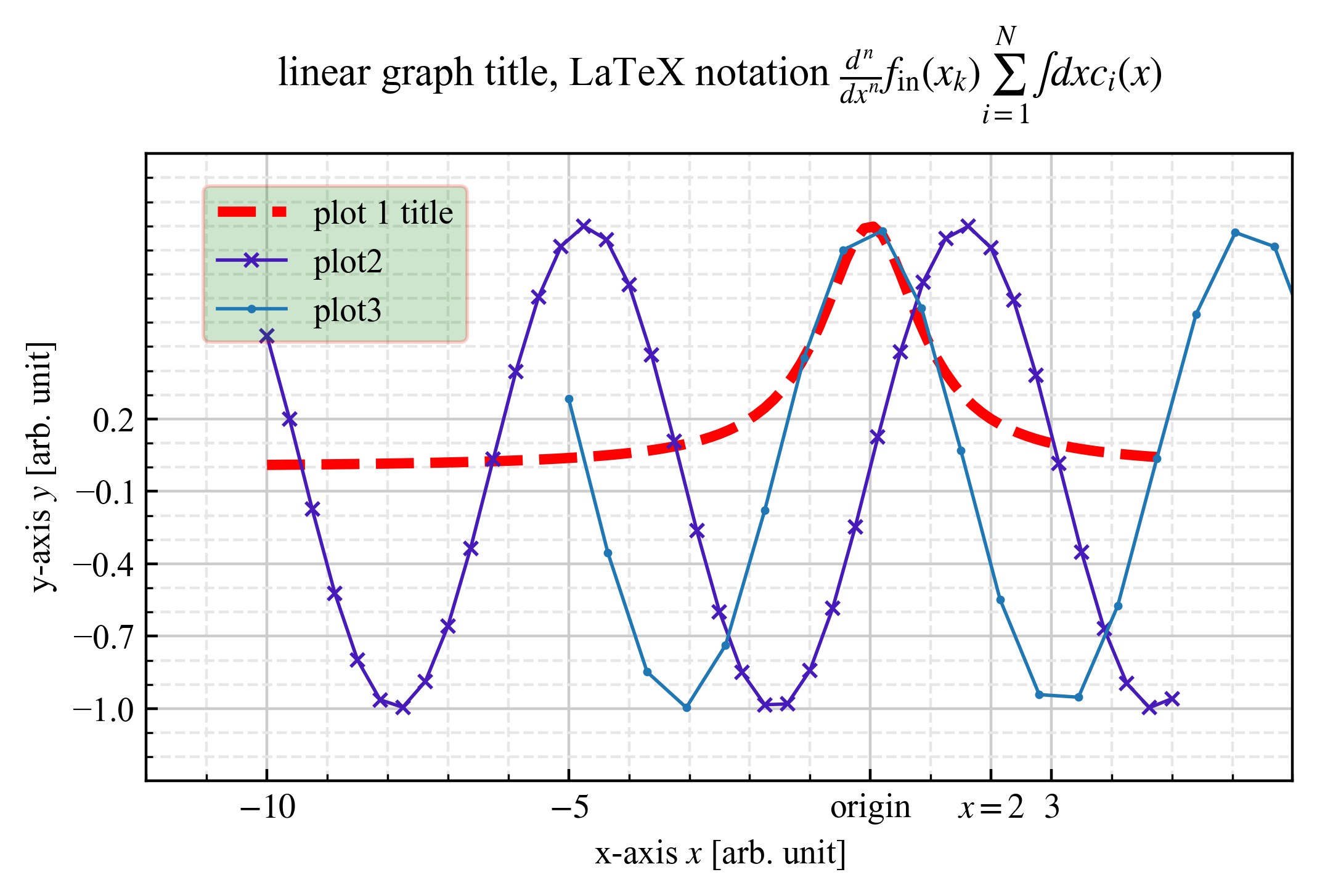
1.5. 対数プロット #
import numpy as np
from plot_xy import plot_xy
if __name__ == "__main__":
x1 = np.logspace(-3, 2.5, 101)
x2 = np.logspace(-3, 3, 101)
y1 = 1.0 / (x1 + 1)
y2 = 0.01 * (1.0 / (x2**3 + 1) + np.exp(0.1 * x2**0.5))
# ------
x = {"plot1": x1, "plot2": x2}
y = {"plot1": y1, "plot2": y2}
data_optional = {
"plot1": {"fmt": "x-", "ti": "plot 1 title", "lw": 1, "lc": "red"},
"plot2": {"fmt": ".-", "ms": 4, "lc": "#471bb9"},
}
output_image = "out_log.png"
x_major_ticks_manual = ([1e-2, 1e-1, 1e0, 1e1, 1e3], ["$10^{-2}$", "$10^{-1}$", "1", "10", "$1000$"])
plot_xy(
x,
y,
output_image_name=output_image,
show_gui=True,
data_optional=data_optional,
title_name="log-axis graph title $f(x)$",
title_font_size=12,
title_v_offset=20,
figure_size=(6, 4),
aspect_ratio="auto",
legend_loc="lower left", # (0.7, 0.2),
legend_transparent=0.2,
legend_bg_color="blue",
legend_edge_color="black",
x_scale="log",
# x_base=10,
x_range=(5e-4, 2e4),
# x_start_tick=5,
# x_end_tick=3,
x_major_ticks_manual=x_major_ticks_manual,
x_label="x-axis $x$ [arb. unit]",
x_grid="both",
x_ticks_direction="out",
is_x_minor_ticks=True,
x_minor_division=10,
# x_minor_ticks_manual=x_minor_ticks_manual,
y_scale="log",
y_base=10,
y_range=(1e-3, 1),
y_start_tick=-1,
y_end_tick=0.3,
# y_major_ticks_manual=y_major_ticks_manual,
y_label="y-axis $f(x)$ [arb. unit]",
y_grid="both",
y_ticks_direction="out",
is_y_minor_ticks=True,
y_minor_division=10,
# y_minor_ticks_manual=y_minor_ticks_manual,
)
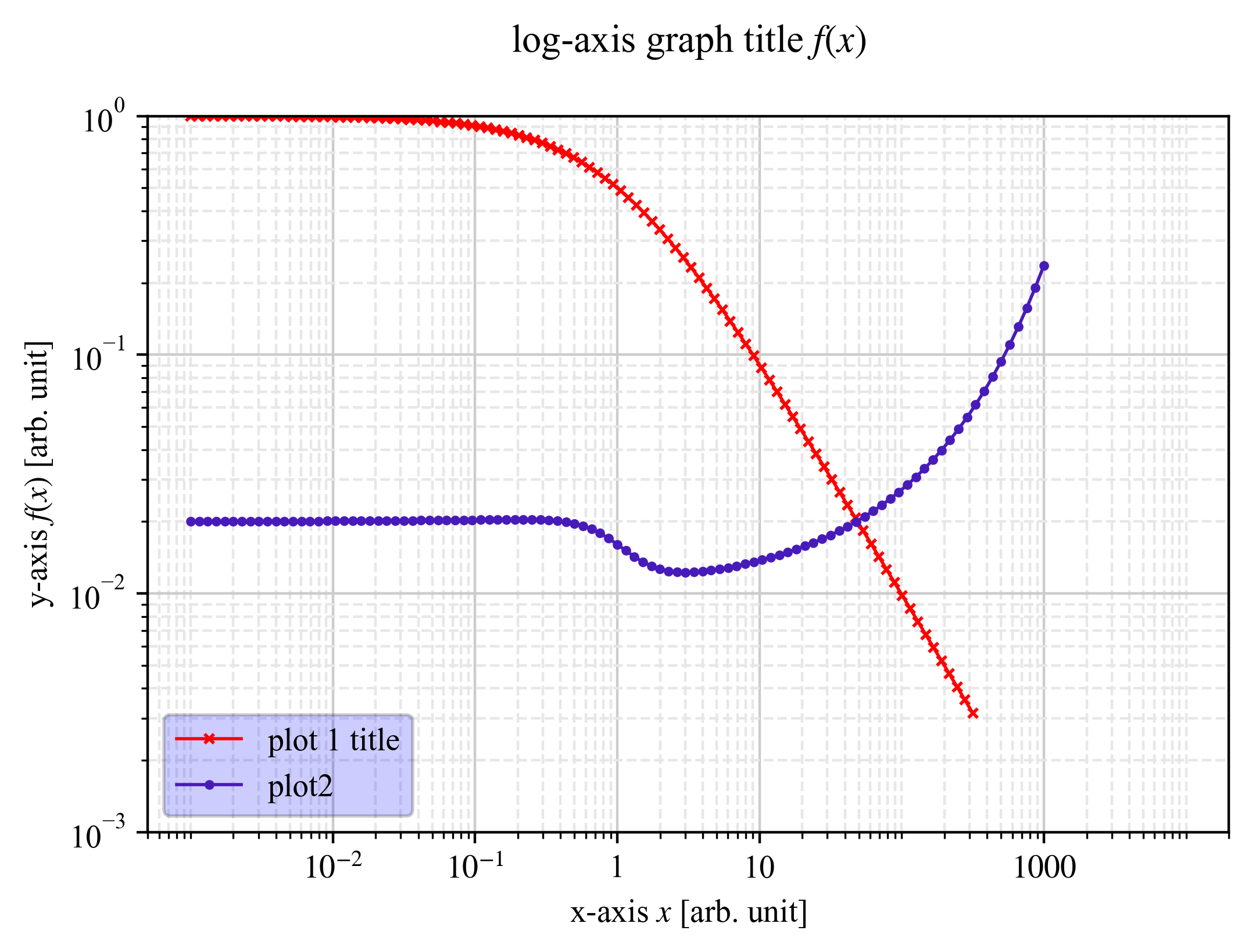
2. $f(x,y)$をカラーマップとして出力・保存する関数 plot_fxy #
def plot_fxy
import numpy as np
import matplotlib.pyplot as plt
import matplotlib.ticker as tck
import matplotlib.colors as mcolors
import matplotlib.patches as mpatches
plt.rcParams["font.family"] = "Times New Roman" # font
plt.rcParams["font.size"] = 10 # character size
plt.rcParams["mathtext.fontset"] = "stix" # font Math
# plt.rcParams["axes.prop_cycle"] = plt.cycler(
# color=["#000000", "#ff0000", "#0000ff", "#228b22", "#ff00ff", "#ffd900", "#00ffff", "#7f00ff", "#ff7f00", "#00ff7f", "#bebebe", "#666666"]
# )
def plot_color2d(
x_mesh: np.ndarray,
y_mesh: np.ndarray,
z_mesh: np.ndarray,
output_image_name: str = None, # "out.png",
show_gui: bool = True,
title_name: str = "x-y graph",
title_font_size: int | str = "default",
title_v_offset: float | str = "default",
figure_size: tuple[int, int] = (8, 5),
aspect_ratio: str | float = "auto",
legend_label: str | None = None,
legend_loc: tuple[float, float] | str | None = None, # "upper left",
legend_transparent: float = 0.5,
legend_bg_color: str = "default",
legend_edge_color: str = "default",
x_scale: str = "linear",
x_base: float | int | str = "auto",
x_start_tick: float = None,
x_end_tick: float = None,
x_range: tuple[float, float] | str = "auto",
x_ticks_manual: tuple | None = None,
x_label: str = "$x$",
x_grid: str = "major",
x_ticks_direction: str = "in",
is_x_minor_ticks: bool = False,
x_minor_ticks_manual: tuple | None = None,
x_minor_division: int | None = None,
x_invert: bool = False,
y_scale: str = "linear",
y_base: float | int | str = "auto",
y_range: tuple[float, float] | str = "auto",
y_start_tick: float = None,
y_end_tick: float = None,
y_ticks_manual: tuple | None = None,
y_label: str = "$y$",
y_grid: str = "major",
y_ticks_direction: str = "in",
is_y_minor_ticks: bool = False,
y_minor_ticks_manual: tuple | None = None,
y_minor_division: int | None = None,
y_invert: bool = False,
color_scale: str = "linear",
color_range: tuple[float, float] | str = "auto",
color_map_name: tuple[float, float] | str = "viridis",
color_transparent: float = 1.0,
color_bar_label: str = "$z$",
color_ticks_manual: tuple | None = None,
default_font_family: str = "Times New Roman",
default_font_size: int = 10,
default_font_set: str = "stix",
) -> None:
plt.rcdefaults()
plt.rcParams["font.family"] = default_font_family # font
plt.rcParams["font.size"] = default_font_size # character size
plt.rcParams["mathtext.fontset"] = default_font_set # font Math
# ===================
# 1. Global settings
# ===================
# - Make figure and subplots
fig, axs = plt.subplots(1, 1, figsize=figure_size)
# - Aspect ratio
axs.set_aspect(aspect_ratio, adjustable="box")
# - Color range
if color_scale == "linear":
norm = None
if color_range != "auto":
norm = mcolors.Normalize(vmin=color_range[0], vmax=color_range[1])
else:
# color_scale == "log"
norm = mcolors.LogNorm()
if color_range != "auto":
norm = mcolors.LogNorm(vmin=color_range[0], vmax=color_range[1])
c = axs.pcolormesh(
x_mesh,
y_mesh,
z_mesh,
shading="auto",
norm=norm,
cmap=color_map_name,
alpha=color_transparent,
)
# - Title
i0 = (
title_font_size
if isinstance(title_font_size, int)
else plt.rcParams["font.size"]
)
f0 = (
title_v_offset
if isinstance(title_v_offset, float)
else plt.rcParams["axes.titlepad"]
)
axs.set_title(title_name, pad=f0, fontsize=i0)
# ========
# 2. Axis
# ========
axs.grid(False)
axs.minorticks_off()
# -----------
# 2.1 x-axis
# -----------
# - x Label
if x_label is not None:
axs.set_xlabel(x_label)
# - x Grid
if x_grid in ["major", "both"]:
axs.grid(
axis="x", which="major", color="#cccccc", linestyle="--", linewidth=1
) # show x-axis grid
if x_grid in ["minor", "both"]:
axs.grid(
axis="x", which="minor", color="#e7e7e7", linestyle="--", linewidth=0.5
) # show x-axis sub-grid
# - x Ticks
axs.tick_params(axis="x", which="both", direction=x_ticks_direction)
if x_scale == "linear":
axs.set_xscale(x_scale)
# -- Major ticks location
if x_ticks_manual is None:
if x_start_tick is None or x_end_tick is None:
if isinstance(x_base, (float, int)):
axs.xaxis.set_major_locator(tck.MultipleLocator(base=float(x_base)))
else:
axs.xaxis.set_major_locator(tck.MaxNLocator(nbins="auto"))
else:
if isinstance(x_base, (float, int)):
# define ticks by start and interval
xstart, xend = axs.get_xlim()
if x_start_tick is not None:
xstart = x_start_tick if x_range != "auto" else x_range[0]
if x_end_tick is not None:
xend = x_end_tick if x_range != "auto" else x_range[1]
ticks = np.arange(xstart, xend, x_base)
axs.set_xticks(ticks)
else:
axs.xaxis.set_major_locator(tck.MaxNLocator(nbins="auto"))
# -- Major ticks label format
mj_formatter = tck.ScalarFormatter()
mj_formatter.set_scientific(True) # Enable Scientific notation
mj_formatter.set_powerlimits(plt.rcParams["axes.formatter.limits"])
# (set_powerlimits: Normal notation range, otherwise Scientific notation.)
mj_formatter.set_useMathText(True) # (False)1e8, (True)10^8
axs.xaxis.set_major_formatter(mj_formatter)
else:
axs.set_xticks(x_ticks_manual[0])
axs.xaxis.set_major_formatter(tck.FixedFormatter(x_ticks_manual[1]))
# -- Minor ticks location
if is_x_minor_ticks:
axs.xaxis.set_minor_formatter(tck.NullFormatter())
if x_minor_ticks_manual is None:
axs.xaxis.set_minor_locator(tck.AutoMinorLocator(n=x_minor_division))
else:
axs.xaxis.set_minor_locator(tck.FixedLocator(x_minor_ticks_manual))
elif x_scale == "log":
axs.set_xscale(x_scale)
x_log_base = x_base if isinstance(x_base, (float, int)) else 10.0
if x_ticks_manual is None:
# -- Major ticks location
# Calc the position at integer power
a_min_list = []
a_max_list = []
a_min_list.append(np.amin(x_mesh))
a_max_list.append(np.amax(x_mesh))
a_min = np.amin(a_min_list)
a_max = np.amin(a_max_list)
n_power_min = np.floor(np.log(a_min) / np.log(x_log_base)).astype(int)
n_power_max = np.ceil(np.log(a_max) / np.log(x_log_base)).astype(int)
ticks = [x_log_base**i for i in range(n_power_min - 1, n_power_max + 2)]
# Set the ticks location clearly
axs.xaxis.set_major_locator(tck.FixedLocator(ticks))
# -- Major ticks label format
mj_formatter = tck.LogFormatterMathtext(base=x_log_base, labelOnlyBase=True)
axs.xaxis.set_major_formatter(mj_formatter)
else:
# axs.set_xticks(x_ticks_manual[0])
axs.xaxis.set_major_locator(tck.FixedLocator(x_ticks_manual[0]))
axs.xaxis.set_major_formatter(tck.FixedFormatter(x_ticks_manual[1]))
# -- Minor ticks location
if is_x_minor_ticks:
if x_minor_division is None:
axs.xaxis.set_minor_locator(tck.LogLocator(base=x_log_base, subs=None))
else:
axs.xaxis.set_minor_locator(
tck.LogLocator(
base=x_log_base,
subs=np.arange(1.0, x_minor_division, 1)
* (1.0 / x_minor_division),
)
)
else:
raise ValueError(f'x_scale must be "linear" or "log", your x_scale={x_scale}')
# - x Range
if isinstance(x_range, tuple):
axs.set_xlim(x_range[0], x_range[1])
else:
axs.set_xlim(auto=True)
if x_invert:
axs.invert_xaxis()
# -----------
# 2.2 y-axis
# -----------
# - y Label
if y_label is not None:
axs.set_ylabel(y_label)
# - y Grid
if y_grid in ["major", "both"]:
axs.grid(
axis="y", which="major", color="#cccccc", linestyle="--", linewidth="1"
) # show y-axis grid
if y_grid in ["minor", "both"]:
axs.grid(
axis="y", which="minor", color="#e7e7e7", linestyle="--", linewidth="0.5"
) # show y-axis sub-grid
# - y Ticks
axs.tick_params(axis="y", which="both", direction=y_ticks_direction)
if y_scale == "linear":
axs.set_yscale(y_scale)
if y_ticks_manual is None:
if y_start_tick is None or y_end_tick is None:
if isinstance(y_base, (float, int)):
axs.yaxis.set_major_locator(tck.MultipleLocator(base=float(y_base)))
else:
axs.yaxis.set_major_locator(tck.MaxNLocator(nbins="auto"))
else:
if isinstance(y_base, (float, int)):
# define ticks by start and interval
ystart, yend = axs.get_ylim()
if y_start_tick is not None:
ystart = y_start_tick if y_range != "auto" else y_range[0]
if y_end_tick is not None:
yend = y_end_tick if y_range != "auto" else y_range[1]
ticks = np.arange(ystart, yend, y_base)
axs.set_yticks(ticks)
else:
axs.yaxis.set_major_locator(tck.MaxNLocator(nbins="auto"))
# -- Major ticks label format
mj_formatter = tck.ScalarFormatter()
mj_formatter.set_scientific(True) # Enable Scientific notation
mj_formatter.set_powerlimits(plt.rcParams["axes.formatter.limits"])
# (set_powerlimits: Normal notation range, otherwise Scientific notation.)
mj_formatter.set_useMathText(True) # (False)1e8, (True)10^8
axs.yaxis.set_major_formatter(mj_formatter)
else:
axs.yaxis.set_major_locator(tck.FixedLocator(y_ticks_manual[0]))
axs.yaxis.set_major_formatter(tck.FixedFormatter(y_ticks_manual[1]))
# -- Minor ticks location
if is_y_minor_ticks:
axs.yaxis.set_minor_formatter(tck.NullFormatter())
if y_minor_ticks_manual is None:
axs.yaxis.set_minor_locator(tck.AutoMinorLocator(n=y_minor_division))
else:
axs.yaxis.set_minor_locator(tck.FixedLocator(y_minor_ticks_manual))
elif y_scale == "log":
axs.set_yscale(y_scale)
y_log_base = y_base if isinstance(y_base, (float, int)) else 10.0
if y_ticks_manual is None:
# -- Major ticks location
# Calc the position at integer power
a_min_list = []
a_max_list = []
a_min_list.append(np.amin(y_mesh))
a_max_list.append(np.amax(y_mesh))
a_min = np.amin(a_min_list)
a_max = np.amin(a_max_list)
n_power_min = np.floor(np.log(a_min) / np.log(y_log_base)).astype(int)
n_power_max = np.ceil(np.log(a_max) / np.log(y_log_base)).astype(int)
ticks = [y_log_base**i for i in range(n_power_min - 1, n_power_max + 2)]
# Set the ticks location clearly
axs.yaxis.set_major_locator(tck.FixedLocator(ticks))
# -- Major ticks label format
mj_formatter = tck.LogFormatterMathtext(base=y_log_base, labelOnlyBase=True)
axs.yaxis.set_major_formatter(mj_formatter)
else:
axs.set_yticks(y_ticks_manual[0])
axs.yaxis.set_major_formatter(tck.FixedFormatter(y_ticks_manual[1]))
# -- Minor ticks location
if is_y_minor_ticks:
axs.yaxis.set_minor_formatter(tck.NullFormatter())
if y_minor_division is None:
axs.yaxis.set_minor_locator(tck.LogLocator(base=y_log_base, subs=None))
else:
axs.yaxis.set_minor_locator(
tck.LogLocator(
base=y_log_base,
subs=np.arange(1.0, y_minor_division, 1)
* (1.0 / y_minor_division),
)
)
else:
raise ValueError(f'y_scale must be "linear" or "log", your y_scale={y_scale}')
# - y Range
if isinstance(y_range, tuple):
axs.set_ylim(y_range[0], y_range[1])
else:
axs.set_ylim(auto=True)
if y_invert:
axs.invert_yaxis()
# ==============
# 3. Color axis
# ==============
# - Color bar
cbar = fig.colorbar(c, ax=axs, label=color_bar_label)
if color_ticks_manual is not None:
cbar.set_ticks(color_ticks_manual[0])
cbar.set_ticklabels(color_ticks_manual[1])
# - Legend position
if legend_label is not None:
patch = mpatches.Patch(label=legend_label)
# - transparent legend background
framealpha = (
legend_transparent
if isinstance(legend_transparent, float)
else plt.rcParams["legend.framealpha"]
)
legend_facecolor = legend_bg_color if legend_bg_color != "default" else None
legend_edgecolor = legend_edge_color if legend_edge_color != "default" else None
plt.legend(
handles=[patch],
loc=legend_loc,
handlelength=0,
handletextpad=0,
framealpha=framealpha,
fancybox=False,
facecolor=legend_facecolor,
edgecolor=legend_edgecolor,
)
# ==========
# 3. Output
# ==========
# - Pop up GUI
if show_gui:
plt.show()
# - output image
if output_image_name is not None:
if output_image_name.endswith(".eps"):
# Don't plot the left-bottom region because the Bounding Box has negative value
fig.subplots_adjust(left=0.3, right=0.9, bottom=0.3, top=0.9)
# Save figure
fig.savefig(output_image_name, dpi=400, bbox_inches="tight")
plt.cla()
plt.clf()
plt.close()
2.1. 要素数の注意 #
座標軸の要素数の違いによって、z軸成分の示す範囲が変わります。
本稿ではmatplotlib.pyplot.pcolormeshのオプションをshading='auto'に固定しています。
そのため、x,y軸の要素数が異なることによってその点を中心に色を付けるか、囲まれた領域の左下の点を基準に色を示すかが変わります。
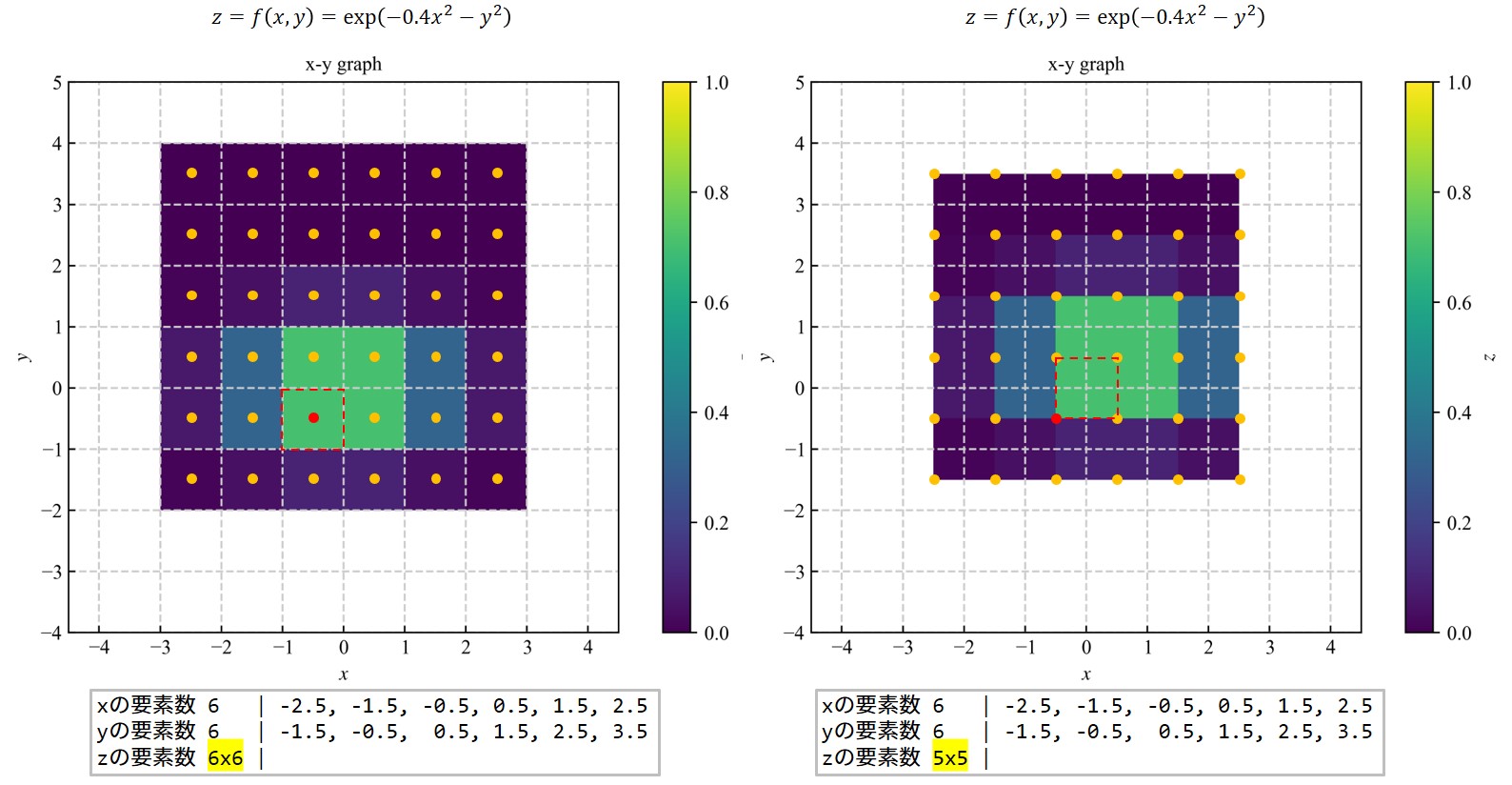
詳細は、下記の公式ページをご覧ください。 pcolormesh grids and shading -matplotlib
2.2. 使用例 #
2.2.1. 与えられた点を中心にカラーを表現 #
- x軸の要素数 $N$
- y軸の要素数 $N$
- z軸の要素数 $N$
import numpy as np
from plot_fxy import plot_color2d
if __name__ == "__main__":
Nx = 6
Ny = 6
x_arr = np.linspace(-2.5, 2.5, Nx)
y_arr = np.linspace(-1.5, 3.5, Ny)
x, y = np.meshgrid(x_arr, y_arr)
z = np.exp(-0.4 * (x - 0) ** 2) * np.exp(-1 * (y - 0) ** 2)
# z = z[:-1, :-1]
print(f"x | {x_arr}") # x | [-2.5 -1.5 -0.5 0.5 1.5 2.5]
print(f"y | {y_arr}") # y | [-1.5 -0.5 0.5 1.5 2.5 3.5]
print(f"x size = {x.shape[0]}, {x.shape[1]}") # x size = 6, 6
print(f"y size = {y.shape[0]}, {y.shape[1]}") # y size = 6, 6
print(f"z size = {z.shape[0]}, {z.shape[1]}") # z size = 6, 6
plot_color2d(
x,
y,
z,
show_gui=True,
output_image_name="out_center.png",
aspect_ratio="equal",
x_range=(-4.5, 4.5),
x_grid="both",
y_range=(-4, 5),
y_grid="both",
color_range=(0, 1),
)
生成される画像
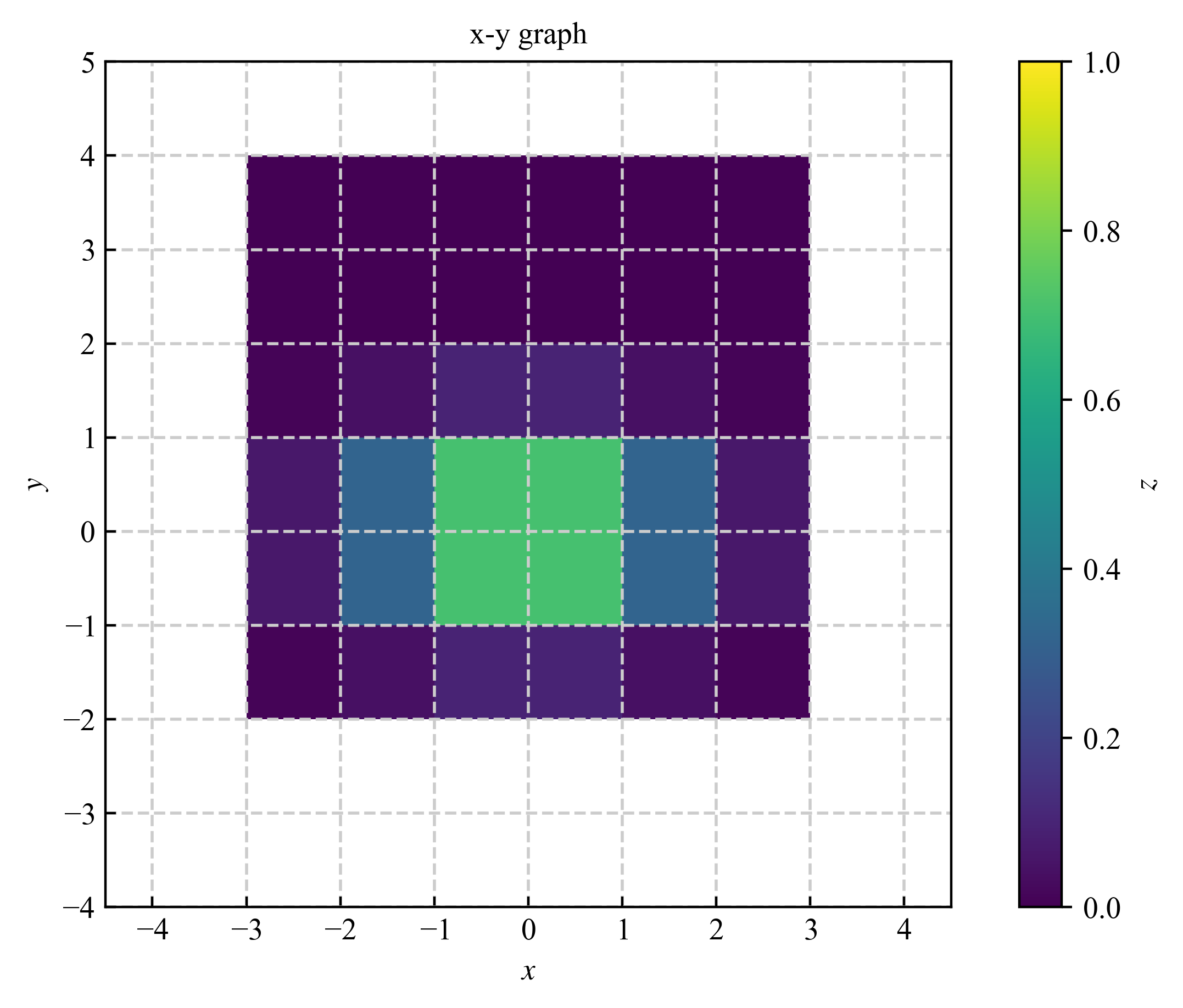
2.2.2. 囲まれた領域と値を指定して表現 #
- x軸の要素数 $N+1$
- y軸の要素数 $N+1$
- z軸の要素数 $N$
import numpy as np
from plot_fxy import plot_color2d
if __name__ == "__main__":
Nx = 6
Ny = 6
x_arr = np.linspace(-2.5, 2.5, Nx)
y_arr = np.linspace(-1.5, 3.5, Ny)
x, y = np.meshgrid(x_arr, y_arr)
z = np.exp(-0.4 * (x - 0) ** 2) * np.exp(-1 * (y - 0) ** 2)
z = z[:-1, :-1]
print(f"x | {x_arr}") # x | [-2.5 -1.5 -0.5 0.5 1.5 2.5]
print(f"y | {y_arr}") # y | [-1.5 -0.5 0.5 1.5 2.5 3.5]
print(f"x size = {x.shape[0]}, {x.shape[1]}") # x size = 6, 6
print(f"y size = {y.shape[0]}, {y.shape[1]}") # y size = 6, 6
print(f"z size = {z.shape[0]}, {z.shape[1]}") z size = 5, 5
plot_color2d(
x,
y,
z,
show_gui=True,
output_image_name="out_region.png",
aspect_ratio="equal",
x_range=(-4.5, 4.5),
x_grid="both",
y_range=(-4, 5),
y_grid="both",
color_range=(0, 1),
)
生成される画像
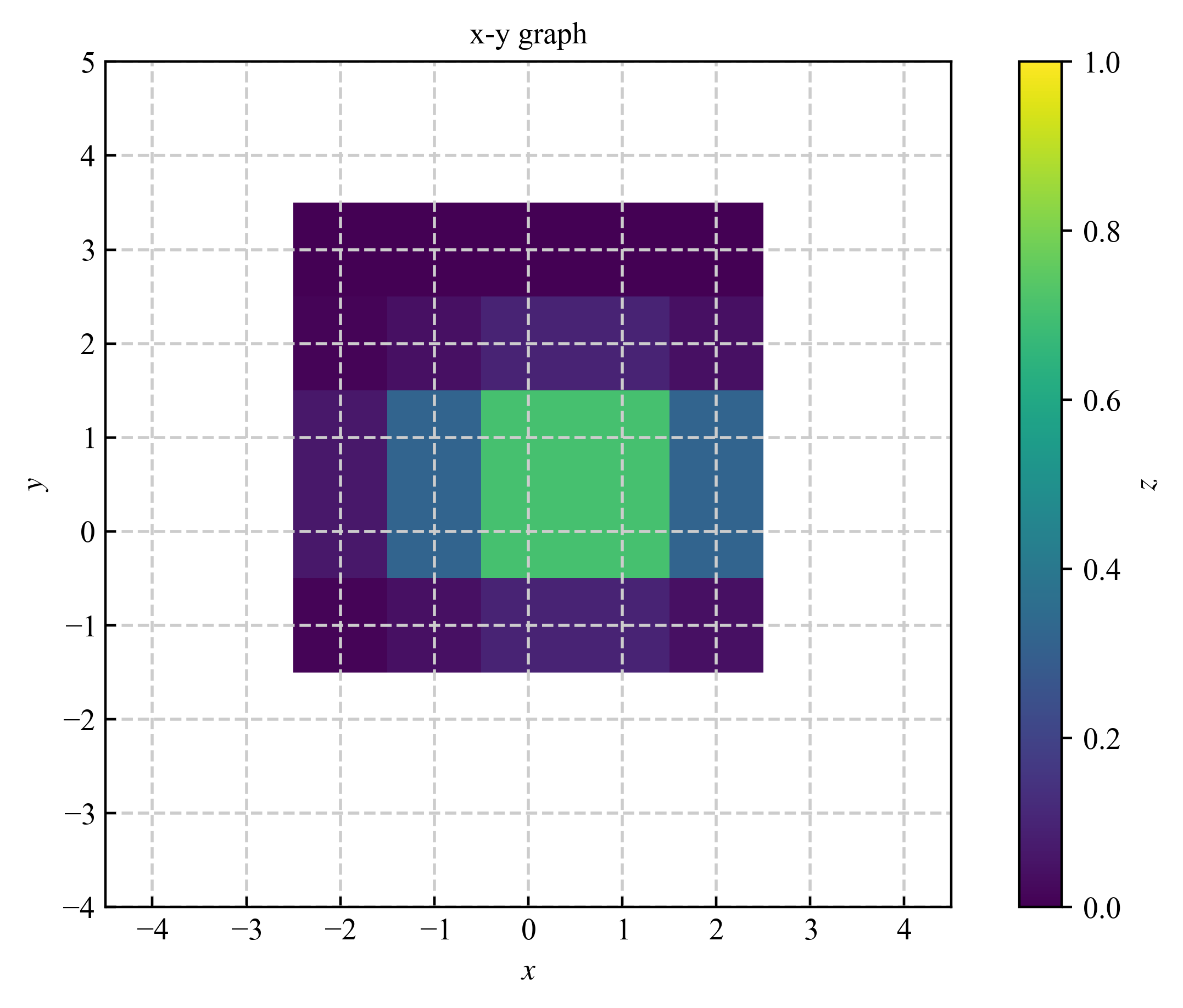
2.2.3. その他実装 #
import numpy as np
from plot_fxy import plot_color2d
if __name__ == "__main__":
N = 6
x_arr = np.linspace(-2.5, 2.5, N)
y_arr = np.linspace(-2.5, 2.5, N)
x, y = np.meshgrid(x_arr, y_arr)
z = np.cos(x - 1) * (1.0 / ((y - 1.5) ** 2 + 1))
z = z[:-1, :-1]
output_image = "out_data_center.png"
x_ticks_manual = ((-3, -1, 0, 1), (-3, -1, "origin", 1))
color_ticks_manual = ([1e-10, 1e-9, 1e-5, 1], ["1e-10", "$10^{-9}$", "$10^{-5}$", "1"])
plot_color2d(
x,
y,
z,
legend_label=None,
output_image_name=output_image,
figure_size=(8, 5),
aspect_ratio="equal",
show_gui=True,
x_base=1,
x_range=(-3.5, 3.5),
x_start_tick=-3,
# x_end_tick=2,
x_ticks_manual=x_ticks_manual,
x_scale="linear",
is_x_minor_ticks=False,
x_minor_division=2,
x_grid="both",
y_base=1,
y_range=(-3.5, 3.5),
y_start_tick=-3,
y_scale="linear",
y_grid="both",
is_y_minor_ticks=False,
y_minor_division=2,
# color_map_name="jet",
color_scale="linear",
color_range=(-1, 1),
# color_ticks_manual=color_ticks_manual,
)
生成される画像
